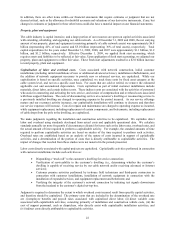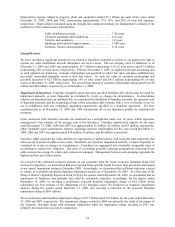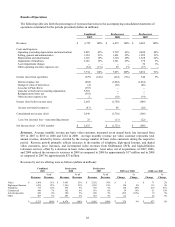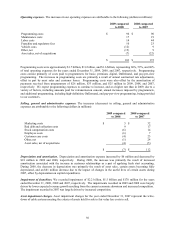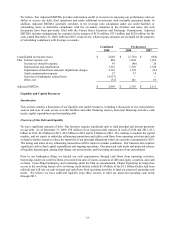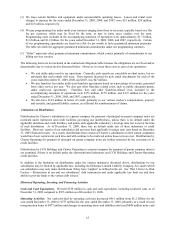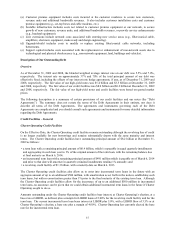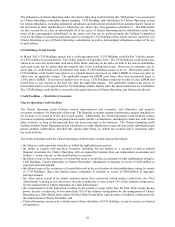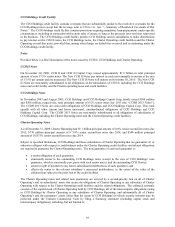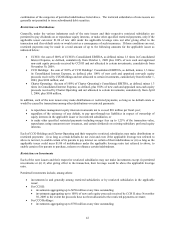Charter 2009 Annual Report Download - page 35
Download and view the complete annual report
Please find page 35 of the 2009 Charter annual report below. You can navigate through the pages in the report by either clicking on the pages listed below, or by using the keyword search tool below to find specific information within the annual report.32
Income tax benefit (expense). Income tax expense for the year ended December 31, 2009 was realized as a result of
increases in certain deferred tax liabilities of certain of our indirect subsidiaries. These increases are primarily
attributable to fresh start accounting adjustments for financial statement purposes and not for tax purposes offset in
part by $71 million of deferred tax benefit related to impairment of franchises. However, the actual tax provision
calculations in future periods will be the result of current and future temporary differences, as well as future
operating results. Income tax benefit for the year ended December 31, 2008 included $32 million of deferred tax
benefit related to the impairment of franchises and $3 million of deferred tax benefit related to asset acquisitions and
sales occurring in 2008. Income tax expense in 2007 was recognized through increases in deferred tax liabilities and
current federal and state income tax expenses of certain of our indirect subsidiaries. Income tax expense for the year
ended December 31, 2007 includes $18 million of income tax expense previously recorded at our indirect parent
company.
Net (income) loss – noncontrolling interest. Noncontrolling interest includes the 2% accretion of the preferred
membership interests in CC VIII plus approximately 18.6% of CC VIII’ s income, net of accretion.
Net income (loss). The impact to net income (loss) as a result of impairment charges, reorganization items, gains
due to Plan effects and fresh start accounting, and extinguishment of debt, net of tax, was to increase net income by
approximately $2.4 billion in 2009, and to increase net loss by approximately $1.5 billion and $264 million in 2008
and 2007, respectively.
Use of Adjusted EBITDA
We use certain measures that are not defined by GAAP to evaluate various aspects of our business. Adjusted
EBITDA is a non-GAAP financial measure and should be considered in addition to, not as a substitute for, net
income (loss) reported in accordance with GAAP. This term, as defined by us, may not be comparable to similarly
titled measures used by other companies. Adjusted EBITDA is reconciled to consolidated net income (loss) below.
Adjusted EBITDA is defined as consolidated net income (loss) plus net interest expense, income taxes, depreciation
and amortization, gains realized due to Plan effects and fresh start accounting adjustments, reorganization items,
impairment of franchises, asset impairment charges, stock compensation expense and other operating expenses, such
as special charges and loss on sale or retirement of assets. As such, it eliminates the significant non-cash
depreciation and amortization expense that results from the capital-intensive nature of our businesses as well as
other non-cash or non-recurring items, and is unaffected by our capital structure or investment activities. Adjusted
EBITDA is used by management and Charter’ s board of directors to evaluate the performance of our business. For
this reason, it is a significant component of Charter’ s annual incentive compensation program. However, this
measure is limited in that it does not reflect the periodic costs of certain capitalized tangible and intangible assets
used in generating revenues and our cash cost of financing. Management evaluates these costs through other
financial measures.


